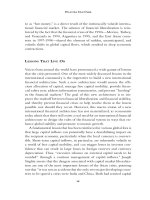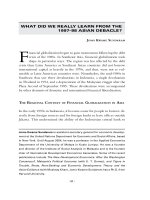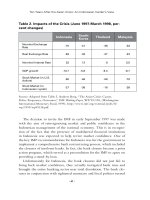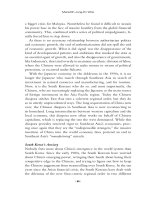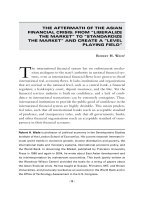Agenor et al (eds ) the asian financial crisis; causes, contagion and consequences (1999)
Bạn đang xem bản rút gọn của tài liệu. Xem và tải ngay bản đầy đủ của tài liệu tại đây (1.26 MB, 452 trang )
This volume presents the first overall analysis, both theoretical and
empirical, of the Asian Financial Crisis. It draws out the general lessons
of an event whose potential long-term effects have been likened to the
Crash of 1929.
Part One presents a factual and analytic overview of what happened:
the role of ‘vulnerability’; the interconnection between currency crises
and financial crises; and why crisis turned into collapse.
Part Two considers more detailed issues, including: how the inflation
of non-traded goods prices created vulnerability, welfare-reducing
capital inflow owing to under-regulated financial markets; and the onset
of speculative attacks.
Part Three assesses the many aspects of contagion, including both the
channels through which it occurs and the role of geographical proximity.
Chapter 12 addresses policy issues. Joseph Stiglitz argues that there is
much that can be done to reduce the frequency of crises, and to mitigate
the severity of crises when they happen, and there is a comprehensive
review of reform proposals. The volume finishes (Chapter 13) with a
Round Table discussion of policy issues.
Pierre-Richard Agénor is Lead Economist and Director of the
Macroeconomic and Financial Management Program of the World
Bank Institute. He has written extensively on stabilisation and
adjustment issues in developing countries. He is the co-author of
Development Macroeconomics (Princeton University Press).
Marcus Miller is Professor of Economics and Associate Director of the
Centre for the Study of Globalisation and Regionalisation at the
University of Warwick. His previous books include Exchange Rate
Targets and Currency Bands (Cambridge University Press, 1994), coedited with Paul Krugman.
David Vines is Fellow in Economics at Balliol College, Oxford. He is the
General Editor of the Research Programme on Global Economic
Institutions of the British Economic and Social Research Council, and
is also a Adjunct Professor of Economics at the Australian National
University.
Axel Weber is Professor of Economics at the Johann Wolfgang GoetheUniversity in Frankfurt/Main, and Director of the Centre for Financial
Studies.
The Asian Financial Crisis
Causes, Contagion and Consequences
The Asian Financial Crisis
Causes, Contagion and Consequences
edited by
Pierre-Richard Agénor, Marcus Miller
David Vines and Axel Weber
CAMBRIDGE UNIVERSITY PRESS
Cambridge, New York, Melbourne, Madrid, Cape Town, Singapore, São Paulo
Cambridge University Press
The Edinburgh Building, Cambridge CB2 2RU, UK
Published in the United States of America by Cambridge University Press, New York
www.cambridge.org
Information on this title: www.cambridge.org/9780521770804
© Pierre-Richard Agénor, Marcus Miller, David Vines and Axel Weber 1999
This publication is in copyright. Subject to statutory exception
and to the provisions of relevant collective licensing agreements,
no reproduction of any part may take place without
the written permission of Cambridge University Press.
First published 1999
This digitally printed first paperback version 2006
A catalogue record for this publication is available from the British Library
ISBN-13 978-0-521-77080-4 hardback
ISBN-10 0-521-77080-7 hardback
ISBN-13 978-0-521-02900-1 paperback
ISBN-10 0-521-02900-7 paperback
Global Economic Institutions
General Editor
David Vines
Balliol College, Oxford
The Global Economic Institutions (GEI) is a series of sixteen linked
research programmes funded by the Economic and Social Research
Council of Great Britain. The programme focuses on how existing global
economic institutions and regimes operate, how they might be improved
and whether new institutions are needed. Its principal findings are being
presented in a sequence of five volumes, published as the series Global
Economic Institutions. The topics covered by the five volumes include the
Asian financial crisis and the role of the International Monetary Fund;
the future of the World Bank; Europe, Asia and regionalism; the international trade regime and the WTO; and the reform of global economic
institutions. Together the volumes will represent a major contribution to
contemporary debates among economists, political scientists, politicians,
business leaders and others with a shared interest in the growth and development of the global economy. Website: />
World Bank Institute
The World Bank Institute (WBI) provides training and other learning
activities that support the World Bank’s mission to reduce poverty and
improve living standards in the developing world. WBI’s programmes help
build the capacity of World Bank borrowers, staff and other partners in
the skills and knowledge that are critical to economic and social development.
For over forty years the WBI has been the Bank’s key instrument for
delivering learning programmes on the full range of development issues to
bank clients. The Institute’s mission is to help build the capacity of clients
in their development efforts through learning programmes. It offers its
programmes to governments, non-governmental organisations and other
stakeholders in topics related to economic and social development. The
Institute delivers its interactive learning programmes using a broad range
of face-to-face and distance education modalities, including seminars,
workshops, conferences and a variety of print, broadcast and multimedia
products.
vii
Centre for Economic Policy Research
The Centre for Economic Policy Research is a network of over 450 Research
Fellows, based primarily in European universities. The Centre coordinates its
Fellows’ research activities and communicates their results to the public and private
sectors. CEPR is an entrepreneur, developing research initiatives with the producers, consumers and sponsors of research. Established in 1983, CEPR is a European
economics research organisation with uniquely wide-ranging scope and activities.
CEPR is a registered educational charity. Institutional (core) finance for the
Centre is provided by major grants from the Economic and Social Research
Council, under which an ESRC Resource Centre operates within CEPR; the Esmée
Fairbairn Charitable Trust and the Bank of England. The Centre is also supported
by the European Central Bank; the Bank for International Settlements; 22 national
central banks and 43 companies. None of these organisations gives prior review to
the Centre’s publications, nor do they necessarily endorse the views expressed
therein.
The Centre is pluralist and non-partisan, bringing economic research to bear on
the analysis of medium- and long-run policy questions. CEPR research may include
views on policy, but the Executive Committee of the Centre does not give prior
review to its publications, and the Centre takes no institutional policy positions. The
opinions expressed in this book are those of the authors and not those of the Centre
for Economic Policy Research.
Executive Committee
Co-Chairmen
Guillermo de la Dehesa
Anthony Loehnis
Jan Krysztof Bielecki
Diane Coyle
Quentin Davies
Bernard Dewe Mathews
Denis Gromb
Philippe Lagayette
Peter Middleton
Bridget Rosewell
viii
Mario Sarcinelli
Kermit Schoenholtz
Philippe Weil
Centre for Economic Policy Research
ix
Officers
President
Chief Executive Officer
Research Director
Richard Portes
Stephen Yeo
Mathias Dewatripont
Centre for Economic Policy Research
90–98 Goswell Road
London, EC1V 7RR
UK
Tel: (44 20 7878) 2900
Fax: (44 20 7878) 2999
Email:
Website:
March 1999
ix
Contents
List of figures
List of tables
Preface
List of conference participants
Acknowledgements
List of abbreviations and acronyms
page xvi
xviii
xxi
xxiii
xxvi
xxvii
Introduction
Pierre-Richard Agénor, Marcus Miller, David Vines
and Axel A. Weber
1
Part One: General Accounts
1
The role of macroeconomic and financial sector linkages in
East Asia’s financial crisis
Pedro Alba, Amar Bhattacharya, Stijn Claessens,
Swati Ghosh and Leonardo Hernandez
1 Introduction
2 Overview of capital flows and economic developments
in East Asia
3 The build-up in vulnerability: a simple analytical
framework
4 Contribution of macroeconomic policies to the
build-up of vulnerability
5 Institutional weakness and macro-financial fragility
in East Africa’s financial sectors
6 Conclusions
Discussion
Sule Ozler
9
xi
xii
Contents
2
3
4
The Asian crisis: lessons from the collapse of financial
systems, exchange rates and macroeconomic policy
Jenny Corbett and David Vines
1 Introduction
2 Vulnerability
3 Asian vulnerabilities
4 Negative shocks
5 Crises and collapse
6 The disintegration of macroeconomic policy making
7 The precondition for a reconstruction of
macroeconomic policy: resolution of sovereign
solvency crises
8 Challenges for the IMF
9 Conclusion: a historical context
Appendix: Thailand, a stylised chronology
Discussion
Christopher Bliss
Are capital inflows to developing countries a vote for or
against economic policy reforms?
Michael P. Dooley
1 What lies behind private capital inflows?
2 Recent private capital inflows into developing
countries
3 Arbitrage capital flows
4 Capital flows in 1994–1998
5 Solutions?
Discussion
Kenneth Kletzer
The Asian crisis: an overview of the empirical evidence and
policy debate
Giancarlo Corsetti, Paolo Pesenti and Nouriel Roubini
1 Introduction
2 Interpreting the Asian crisis
3 The empirical evidence: a first look
4 Strategies to recover from the crisis
5 The Asian crisis and the debate on capital controls
6 Open issues
Appendix
Discussion
Richard Portes
67
112
127
Contents
xiii
Part Two: Theoretical Contributions
5
Capital markets and the instability of open economies
167
Philippe Aghion, Philippe Bacchetta and Abhijit Banerjee
1 Introduction
2 A simple framework
3 Financial liberalisation and macroeconomic volatility
4 Monetary and exchange rate policy
5 Policy conclusions
Appendix 1: solving the model in the Leontief case
Appendix 2: why full financial liberalisation – unlike foreign
direct investment – may destabilise an emerging market economy
Discussion
Gianluca Femminis
6
Volatility and the welfare costs of financial market integration 195
Pierre-Richard Agénor and Joshua Aizenman
1 Introduction
2 The basic framework
3 Financial autarky
4 Financial openness
5 Welfare effects of financial integration
6 Endogenous supply of funds
7 Congestion externalities
8 Conclusions
Discussion
John Driffill
7
A theory of the onset of currency attacks
Stephen Morris and Hyun Song Shin
1 Introduction
2 Elements of a theory
3 The incomplete information game
4 The argument
5 The limiting case
6 Concluding remarks
Discussion
Jonathon P. Thomas
230
xiv
Contents
Part Three: Contagion
8
9
10
Contagion: monsoonal effects, spillovers and jumps between
multiple equilibria
Paul Masson
1 Introduction
2 Empirical evidence
3 Models with multiple equilibrium
4 Conclusions
Discussion
Axel A. Weber
Contagion and trade: why are currency crises regional?
Reuven Glick and Andrew K. Rose
1 Introduction
2 The regional nature of currency crises
3 Channels of contagion
4 Methodology
5 Results: explaining the incidence of currency crises
6 Results: explaining the intensity of currency crises
7 Conclusions
Appendix
Discussion
Mark P. Taylor
Competition, complementarity and contagion in East
Asia
Ishac Diwan and Bernard Hoekman
1 Introduction
2 Real-side stories
3 Linkages between East Asian economies
4 Patterns of trade
5 Direct investment flows
6 Conclusions
Appendix
Discussion
Jenny Corbett and David Vines
265
284
312
Contents
xv
Part Four: Policy Responses
11
Coping with crises: is there a ‘silver bullet’?
Amar Bhattacharya and Marcus Miller
1 Introduction: globalisation challenged
2 Six key ideas in the debate
3 Elements of the East Asia crises: creditor panic, asset
bubbles and sharks
4 The strategic case for changing the rules of the game
5 Improving the financial architecture
6 Conclusions
357
12
Must financial crises be this frequent and this painful?
Joseph Stiglitz
1 The evidence that crises are frequent and painful
2 Should we do something about economic crises?
3 Are there feasible interventions to prevent crises?
4 Are there feasible interventions to improve responses
to crises?
5 Conclusions
386
13
Round Table discussion
Richard Portes, Phillip Turner and Charles A. Goodhart
404
Index
412
Figures
1.1
1.2
1.3
1.4
1.5
1.6
1.7
1.8
1.9
1.10
1.11
1.12
1.13
1.14
1.15
1.16
1.17
2.1
5.1
5.2
5.3
5.4
5A.1
D5.1
6.1
xvi
Macroeconomic developments in Asia, 1980–1996
page 15
Self-reinforcing dynamics resulting in increased vulnerability
19
Lending booms in East Asia, 1989–1996
21
Profitability and efficiency in East Asian banking, 1991
and 1995
22
Banks’ exposure to risky assets, 1991–1995
23
Real estate office supply and vacancy rates, 1988–1999
25
Foreign exchange exposures in the banking system, 1986–1996 27
Increasing liquidity risks in corporate Asia, end-1996
29
External debt indicators, 1996
30
Short-term debt, June 1997
31
GDP growth and its components, 1989–1997
36
Banking sector fragility in Asia, June 1997
50
Financial fragility in Asia, June 1997: contributing factors –
destabilising credit
51
Capital/asset ratio, NPLs and recapitalisation need, 1998
52
Loan loss provisions, 1988–1995
54
Transparency and quality of disclosure, 1997: overall rating
55
Financial fragility in Asia, 1997: contributing factors –
lending, disclosure and compliance
56
Inter-relationship between currency crises and financial crisis:
the four stages of currency collapse
68
The timing of events
170
Wealth and price effects
172
An endogenous cycle
173
Capital inflows after a liberalisation
175
Permanent cycles
181
Dynamic behaviour of WB when (1-␣)r is about 1
187
Secondary market yield spreads on US dollar-denominated
euro bonds, September 1994–December 1997
196
List of figures
6.2
6.3
6.4
6.5
6.6
6.7
6.8
6.9
6.10
6.11
6.12
6.13
7.1
7.2
7.3
7.4
8.1
8.2
8.3
8.4
10.1
10.2
10.3
10.4
11.1
11.2
12.1
12.2
12.3
Bank spreads: domestic vs. foreign banks, 1988–1995
Overhead costs: domestic vs. foreign banks, 1988–1995
Net profits: domestic vs. foreign banks, 1988–1995
Developing countries: foreign bank penetration vs. overhead
costs and net profits, 1988–1995
Interest rate and expected repayment
Domestic interest rate – banks’ cost-of-funds’ curve
Domestic welfare under openness
Domestic welfare and volatility of banks’ funding cost under
openness
Endogenous savings: welfare under autarky
Endogenous savings: welfare under openness
Congestion externalities: welfare under autarky and openness
The effect of congestion externalities
⑀ small but positive
(x)
Proof of lemma 3
Effect of shifts in ⑀
Stripped yield spreads, selected Brady bonds, January 1994–
January 1998
US dollar per domestic currency unit, January 1994–
January 1998
Mexican interest rates and foreign reserves and US interest
rates, January–December 1994
Effective exchange rates and the Japanese yen per US dollar
rate, January 1992–January 1998
Significant beta of GDP growth with respect to GDP growth
of China or Japan, 1980–1994
Significant beta of investment growth with respect to
investment growth of China or Japan, 1980–1995
Significant beta of GDP growth with respect to GDP growth
of China or Japan, 1980–1994
Significant beta of export growth with respect to consumption
growth of China or Japan, 1980–1995
Elements of the East Asian crisis
The strategic case for a payments standstill
Incidence of financial crises worldwide, 1970–1997
1998 GDP consensus forecast, June 1997–September 1998
Cumulative lost output relative to trend, 1998
xvii
201
202
203
204
205
207
210
212
214
215
218
220
241
247
250
251
269
270
271
273
319
320
321
322
367
370
357
388
389
Tables
1.1
1.2
1.3
1.4
1.5
1.6
1.7
1.8
1.9
1.10
1.11
1.12
3.1
4.1
4.2
4.3
4.4
4.5
7.1
7.2
8.1
xviii
Magnitude and composition of capital inflows,
page 11
1985–1996
Investment, savings and capital flows, 1985–1996
12
The credit channel in East Asia
19
Increasing corporate vulnerability in East Asia, 1991–1996
28
Correlation between private capital flows and changes in
excess demand pressures, 1990–1996
33
Symptoms of macroeconomic over-heating, 1993–1996
38
Estimates of monetary policy reaction functions
40
Estimates of the offset coefficient
41
Correlation between the fiscal impulse and excess demand
pressures
43
Magnitude of the variability in the nominal exchange rate
44
Summary of policy mix
46
Investor protection in Asia and Latin America
58
Private capital inflows as a percentage of GDP, Asia and the
Western Hemisphere, 1970–1993
116
Crisis and economic indicators, December 1996–December
1997
132
Explaining the crisis index: basic regressions
136
Explaining the crisis index: the role of fundamentals and
reserves
138
Explaining the crisis index: fiscal implications of financial
fragility
139
Explaining the crisis index: bail-out costs, fundamentals and
reserves
140
Undermining the peg
235
Matrix of payoffs
237
Selected Southeast Asia countries: exports to various
country groups, 1996
272
List of tables
8.2
8.3
9.1
9.2
9.3
9.4
9.5
9A.1
9A.2
10.1
10.2
10.3
10.4
10.5
10.6
10.7
10.8
10.9
10.10
10A.1
10A.2
10A.3
10A.4
10A.5
11.1
Selected Latin American countries: exports to various
country groups, 1996
Selected Asian economies: real effective exchange rates,
January 1997–March 1998
Regional distribution of currency crises, 1971–1997
T-tests for equality, by crisis incidence, 1971–1997
Probit estimates of cross-country crisis incidence on trade
linkage and macroeconomic controls, 1971–1997
Multivariate OLS results for exchange rate pressure,
1971–1997
Multivariate OLS results for exchange rate pressure: sixmonth horizon, 1971–1997
Countries affected by speculative attacks, 1971–1997
Default measure of trade linkage, 1971–1997
Regressions on macro aggregates, 1970–1995
East Asia: intra- and extra-regional trade, 1990–1997:2
Intra-regional exports, by country, 1995
Export intensity of total trade, 1996
Share of intermediates in global exports of East Asian
countries, 1995
Share of intermediates in total imports from East Asia,
North America and the EU, 1995
Intensity of intermediate-goods’ exports, 1996
Export similarity, 1995
Export share correlations in intra-regional and extraregional trade, 1996
Net private long-term capital flows to developing countries,
by country group, 1990–1996
Share of intermediates in global exports of East Asian
countries, by destination, 1995
Share of intermediates in total exports to East Asia, North
America and the EU, 1995
Correlations of export vectors, top nine countries, 1995
Japanese FDI to the world, 1989–1996
Japanese FDI to East Asia, 1989–1996
A liquidity crisis: outcomes and payoffs
xix
274
275
290
293
294
298
299
301
302
318
325
326
328
330
331
332
334
335
337
341
341
342
343
344
370
Preface
The Asian financial crisis hit the most rapidly growing and successful
economies in the world, plunging them into deep crisis, with effects that will
be felt for years to come; and it has, of course, generated an enormous
policy debate. But little has been published in academic form. This book is
intended to help fill the gap with a carefully selected set of papers covering
the causes and consequences of the crisis, and possible cures.
Most of the contributions were commissioned for two key conferences
on the Asian crisis held in England in May and July 1998. These meetings,
at London and Warwick Universities, respectively, were collaboratively
organised by the Centre for Economic Policy Research (CEPR), the World
Bank Institute (WBI), the ESRC’s Global Economic Institutions (GEI)
Programme, the Centre for the study of Globalisation and Regionalisation
of Warwick University (CSGR), and the Department of Economics at
Warwick University (financed by ESRC project no. L120251024, ‘A
Bankruptcy Code for Sovereign Borrowers’). Additional financial support
was also provided by Credit Suisse First Boston (CSFB). The meetings
brought together a lively group of authors, discussants, and others from
Europe, the USA and elsewhere, including members of the IMF and the
World Bank, as well as academics and market participants. These meetings
grew, in part, out of two earlier gatherings held in Cambridge and London
in July 1997, and in London in February 1998, organised by CEPR, and
funded by the UK Foreign and Commonwealth Office, HM Treasury, the
Bank of England and the GEI Programme of the ESRC.
In addition to the papers commissioned for the conferences, related contributions by two of the participants have been included, chapters 3 and 12
by Michael Dooley and Joseph Stiglitz, respectively. The editors believe
that these add substantially to the unity of the volume.
This is the second of a series of publications stemming from the Global
Economic Institutions Programme of the UK Economic and Social
Research Council. The first book, Europe, East Asia and APEC: a Shared
xxi
xxii
Preface
Global Agenda, was published in April 1998 in collaboration with the
Australia–Japan Research Centre. Two more volumes, one on the future of
the World Bank, and the other on Subsidiarity in the Global Economy are
in the final stages of preparation, and there are plans for another on the
overall future of global economic institutions.
Pierre-Richard Agénor
Marcus Miller
David Vines
Axel Weber
March 1999
Acknowledgements
The editors and publisher acknowledge with thanks permission from the
following to reproduce copyright material.
Goldman-Sachs, for data in figures 1.5, 1.12, 1.15 and 1.16.
JP Morgan, for data in figure 1.13.
University of Chicago Press, for data in figure 1.14.
Bloomberg, for data in figures 6.1 and 8.3.
Reuters, for data in figure 8.1.
Salomon Brothers, for data in figure 8.1.
Journal of Finance, for data in table 6.1, from R. La Porta, F. Lopez de
Silanes, A. Shleifer and R.W. Vishny, ‘Determinants of External
Finance’ (1997).
Journal of Political Economy, for data in table 6.1, from R. La Porta, F.
Lopez de Silanes, A. Shleifer and R.W. Vishny, ‘Law and Finance’
(1998).
xxvi
List of abbreviations and acronyms
ADB
ASEAN
BI
BIBF
BIS
BOT
CAR
CD
CEE
CSFB
COMECON
CPI
DC
EEF
EMS
ERM
EPF
EU
FDI
FIRREA
G-7
G-10
G-22
GDP
GEI
IAS
IBC
ICOR
IFI
Asian Development Bank
Association of South-East Asian Nations
Bank Indonesia
Bangkok International Banking Facility
Bank for International Settlement
Bank of Thailand
capital/asset ratio
certificate of deposit
Central and Eastern Europe
Credit Suisse First Boston
Council for Mutual Economic Aid (FSU)
Consumer Price Index
developing country
Exchange Equalisation Fund
European Monetary System (EC)
Exchange Rate Mechanism (EC)
Employees’ Provident Fund
European Union
foreign direct investment
Financial Institutions Reform, Recovery and Enforcement
Act (1989)
Group of Seven
Group of Ten
Group of Twenty-Two
gross domestic product
global economic institution
International Accounting Standard
International Bondholders’ Corporation
incremental capital output ratio
international financial institution
xxvii
xxviii
List of abbreviations and acronyms
IMF
LIBOR
LOLR
MAR
MSB
NAFTA
NBFI
NIE
NPL
NPV
OMO
OPEC
OTC
PPP
S&L
SRF
SRR
TFP
UIP
VaR
WBI
International Monetary Fund
London Interbank Offer Rate
lender-of-last-resort
market average rate
Monetary Stabilisation Bond
North American Free Trade Agreement
Non-bank Financial Institution
newly industrialised economy
non-performing loan
net present value
open-market operation
Organisation of Petroleum-Exporting Countries
over-the-counter
purchasing power parity
Savings and Loan
supplemental reserve facility
statutory reserve requirement
total factor productivity
uncovered interest parity
value-at-risk
World Bank Institute

